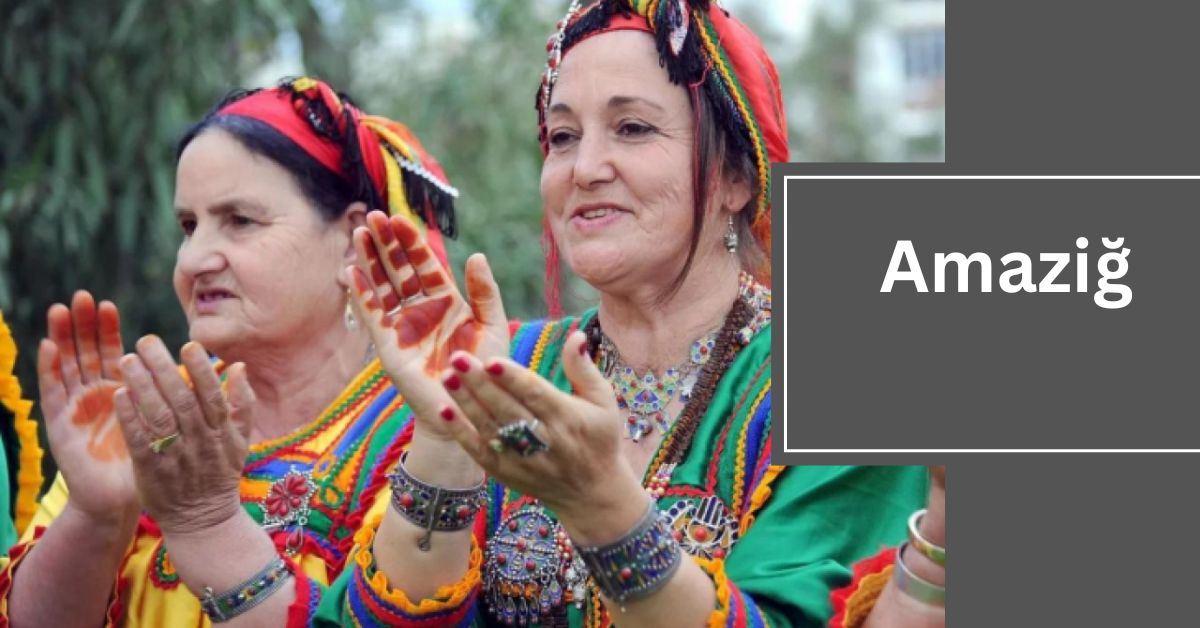Amaziğ – Recognize The Value Of Amazigh Culture!
My grandma’s stories about our Amazigh family make me strong. Learning the Amazigh language helps me understand where I come from. Being Amazigh makes me feel proud and happy.
The Amaziğ (also known as Berbers) are an indigenous people native to North Africa. They have a rich cultural heritage and a history dating back to at least 10,000 BC. The Amazigh language, Tamazight, and their unique traditions continue to thrive today.
In this article, we will talk about the Amazigh people. We will explore their interesting history, their special language and writing system, and their unique customs and traditions. We will also discuss how they have managed to keep their identity and culture alive despite many challenges.
Who Are The Amazigh People?– Discover Their History, Language, And Traditions!
The Amazigh (also known as Berbers) are an indigenous ethnic group native to North Africa. They have a rich history and a distinct cultural identity. Here are some key facts about the Amazigh people .
Name: The name “Amazigh” means “free people” in their native language, Tamazight. They prefer this name over “Berber,” which was given to them by colonizers and has negative connotations.
Language: Tamazight is the language spoken by the Amazigh. It has several varieties, including Taqbaylit, Chenoua, and Tamasheq.
Religion: Most Amazigh people are Sunni Muslims, but some practice Christianity or hold traditional beliefs.
Population: Estimates suggest there are around 25 million Amazigh people, primarily living in Algeria and Morocco. Smaller communities exist in Tunisia, Libya, and Egypt.
History: The Amazigh have a long history in North Africa, dating back to before the Arab conquest in the seventh century. They have faced colonization, suppression of their culture and language, and struggles for recognition.
Identity: The Amazigh have a distinct cultural identity and have fought to preserve their language, customs, and traditions. They celebrate their own new year and have a unique flag, the Yaz.
Recognition: In recent years, there has been progress in recognizing Amazigh rights. In Algeria, Tamazight was recognized as a national language in 2002 and an official language in 2016. The Amazigh new year is also celebrated as a public holiday.
The Amazigh people have a rich heritage and continue to work towards preserving their identity and achieving greater recognition and acceptance.
Also read: Vy6ys – Embrace The Future In 2024!
The Amazigh People?– Spread Across North Africa, Yet United in Their Quest for Recognition!
The Amazigh people, also called Berbers, are native to North Africa and have lived there for thousands of years. The name “Amazigh” means “free people,” and they prefer this name over “Berber,” which was given by outsiders.

They mainly live in Algeria and Morocco, but some also live in Tunisia, Libya, and Egypt. The Amazigh have their own language, called Tamazight, and a rich culture full of music, art, and traditional dances.
They have faced many challenges, such as discrimination and efforts to erase their culture, but they continue to celebrate and protect their unique identity and traditions.
What Is The History Of The Amazigh People?– Uncover The Hidden History Of The Amazigh People!
The history of the Amazigh people is a long and fascinating story that spans over 10,000 years. Here is a detailed account of their history, written in easy-to-understand language:
Prehistory (10,000 BCE – 500 BCE):
- The Amazigh people were the original inhabitants of North Africa, living in the region for thousands of years.
- They developed a unique culture, language, and traditions, and were skilled farmers, herders, and craftsmen.
- They built sophisticated cities, like the ancient city of Utica in present-day Tunisia.
Phoenician and Roman Era (500 BCE – 500 CE):
- The Phoenicians, a Semitic people from the Middle East, arrived in North Africa and established trade and cultural exchange with the Amazigh.
- The Romans later conquered the region, introducing their language, religion, and customs.
- Many Amazigh people adopted these new influences, but maintained their cultural identity.
Islamic Conquest (500 – 1500 CE):
- Arab armies arrived in North Africa, introducing Islam and establishing new political and cultural systems.
- Many Amazigh people converted to Islam, but retained their cultural traditions and language.
- Amazigh dynasties like the Almoravids and Almohads ruled much of North Africa and Spain.
Medieval Period (1500 – 1800 CE):
- Amazigh tribes maintained their independence and cultural identity, despite Ottoman and European colonization.
- The Amazigh people developed a rich literary and artistic tradition, including poetry, music, and crafts.
Colonial Era (1800 – 1960 CE):
- European powers like France, Spain, and Italy colonized North Africa, suppressing Amazigh culture and language.
- Amazigh people were forced to adopt European languages and customs, and their cultural practices were marginalized.
Modern Era (1960 CE – present):
- Amazigh people began to fight for recognition, rights, and cultural preservation.
- In Morocco, Algeria, and Tunisia, Amazigh movements demanded official recognition of their language and culture.
- Today, Amazigh people continue to face challenges, but also celebrate their cultural heritage and resilience.
Also read: Clochant – A Complete Guide2024!
What Are Amazigh Customs And Traditions?– Embrace The Vibrant Culture Of The Amazigh People!
The Amazigh people have rich customs and traditions. They enjoy traditional music and dances like Ahidous, which involves men and women dancing together in a circle. They create beautiful art and crafts, including pottery, woven textiles, and jewelry.

Amazigh hospitality is famous; they warmly welcome guests with tea and food. Their festivals, like the Amazigh New Year (Yennayer), are celebrated with music, dance, and traditional foods. Storytelling is important to them, with tales of ancestors and myths being passed down through generations.
What Is The Amazigh Writing System?– Learn Tifinagh, Empower Amazigh Culture!
The Amazigh writing system is called Tifinagh, which is derived from the old Berber script ¹ ². Here’s a detailed explanation of the Tifinagh alphabet in simple terms:
What is Tifinagh?
- Tifinagh is an ancient writing system used by the Amazigh people.
- It is thought to have originated from the Phoenician alphabet.
- The name “Tifinagh” possibly means “the Phoenician letters” or “our invention.”
Versions and Usage
- Versions of Tifinagh are used to write Berber languages in Morocco, Algeria, Mali, and Niger.
- The Arabic and Latin alphabets are also used to write Berber languages.
- The modern Tifinagh script is also known as Tuareg, Berber, or Neo-Tifinagh.
History
- In 2003, Tifinagh became the official script for the Tamazight language in Morocco.
- It was banned in Libya by Colonel Gadhafi’s government but is now used again.
- The Tuareg people, particularly women, use Tifinagh for private notes, love letters, and decoration.
Characteristics
- Tifinagh is written from right to left.
- It consists of 33 letters and uses symbols, including straight and angular strokes, vertical and horizontal lines, circles, and dots.
- Berber characters are often engraved on surfaces like stone and wood.
Online Resources
- You can find Tifinagh alphabet charts, fonts, and transliteration tools online.
- Websites like Omniglot and dCode offer resources and tools for encoding and decoding Tifinagh text.
Example
- The word “SAHEL” can be written in Tifinagh as “ⵙⴰⵀⴻⵍ”.
- The symbols “ⵜⴼⵏⵗ” can be transcribed as “TFNGh” and read as “Tifinagh”.
Also read: Çeciir – Discover The Richness Of Turkish Cuisine!
Are Amazigh People Muslims?– Respect And Celebrate Amazigh Diversity!
Yes, most Amazigh people are Muslims, following the Sunni branch of Islam. However, before Islam, they had their own traditional beliefs, and some Amazigh still practice these today.

A few Amazigh people also follow other religions like Christianity and Judaism, especially in places with historical connections to these faiths. Even as Muslims, the Amazigh people keep many of their unique cultural traditions and customs, blending them with their religious practices.
What Challenges Do Amazigh People Face?– Stand In Solidarity With The Amazigh People!
Linguistic and Cultural Erasure
- Suppression of their language, Tamazight, in favor of dominant languages like Arabic and French.
- Efforts to erase their cultural heritage and replace it with dominant cultures.
- Limited representation in media, education, and cultural institutions.
Discrimination and Marginalization
- Prejudice and stereotypes perpetuated by dominant groups.
- Limited access to education, employment, and healthcare.
- Exclusion from political decision-making and representation.
Land and Resource Disputes
- Forced removals from ancestral lands for development projects.
- Lack of control over natural resources, like water and minerals.
- Limited access to fertile land and resources for farming and herding.
Political Underrepresentation
- Limited representation in government and parliament.
- Lack of political power and decision-making authority.
- Inadequate representation in international forums.
Socioeconomic Inequality
- Higher rates of poverty, illiteracy, and unemployment.
- Limited access to basic services like healthcare, education, and sanitation.
- Inadequate economic opportunities and infrastructure.
Environmental Challenges
- Climate change affecting agriculture and herding.
- Limited access to clean water and sanitation.
- Environmental degradation due to mining and pollution.
Call to Action
- Learn about Amazigh history, culture, and struggles.
- Support Amazigh language and cultural preservation efforts.
- Advocate for Amazigh rights and representation.
- Amplify Amazigh voices and stories.
- Join the movement for inclusivity and social justice!
By understanding these challenges, we can work together to address them and support the Amazigh people in their struggle for recognition, equality, and justice.
Also read: Sonya Hamlin Idris Elba – Everything Bout Her Life!
Conclusion:
In conclusion, the Amazigh people face various challenges despite their rich cultural heritage. It is crucial to recognize and respect their rights, promote their language and culture, and support their development.
Read more:







